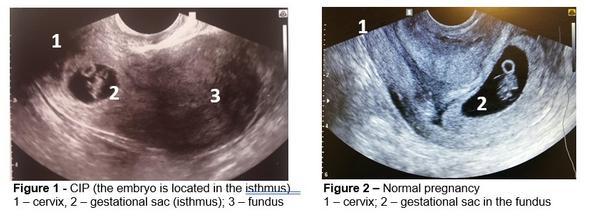This leaflet is to help you understand what Cervico-isthmic pregnancy (CIP) is, what tests you need, and the implication of being diagnosed for you and your baby.
What is a Cervico-isthmic pregnancy (CIP)?
A CIP is a pregnancy that occurs when the gestational sac implants and develops in an abnormal location - the isthmus (the area between the body of the uterus and the cervix - Figure 1). A normal pregnancy develops in the fundus of the uterus, which is more suitable for a normal fetal growth (Figure 2).

What are the risks of a CIP for the mother?
A CIP is a very high-risk pregnancy. It is associated with bleeding during pregnancy and at delivery, which can be massive and life-threatening. This is believed to happen for 2 reasons. Firstly, the isthmus does not contract as the rest of the uterus and this contraction is what stops the blood flow after delivery. Secondly, in almost all cases of CIP the placenta is abnormally adherent to the uterus (called a placenta accreta spectrum disorder), and cannot be detached easily and, if removed, can lead to significant bleeding. Because of this complication, most cases of CIP that grow beyond the 20th week require hysterectomy (the removal of the uterus) after delivery in order to stop the bleeding and preserve the mother’s life.
What are the risks of a CIP for the baby?
The risks for the baby are those associated with prematurity, i.e. being born too early. In a normal pregnancy, the cervix remains closed until the end of gestation. In a CIP, the pregnancy grows near the cervix and exerts pressure on it, leading to its shortening and opening early in the pregnancy. If this happens before the 24th week, the baby probably will not be able to survive. After that time, if the baby is very premature it may survive with complications.
What are the things to watch for during the pregnancy?
Depending on the legislation in your country, you may ask for termination of the pregnancy, given the complications and the outcomes associated with a CIP. If the couple decides to continue the pregnancy, it is important to keep in mind that there may be episodes of massive bleeding or an early labor (painful contractions at regular intervals). Ultrasound can be used to monitor the progression of the pregnancy in the uterus, the length of the cervix and the possibility of an abnormally adherent placenta. Other exams, such as MRI, can be helpful.
What can happen during the delivery?
If the placenta seems abnormally adherent to the uterus, the safest procedure for the mother is to remove the uterus after the birth of the baby without trying to remove the placenta. The delivery should be prepared by a multidisciplinary team considering that the blood loss can be critical. The couple should be prepared for the possibility to remove the uterus, which is the most likely scenario if the bleeding cannot be properly controlled.
What other questions should I ask?
- Is my pregnancy a CIP or a cervical pregnancy?
- What are the risks if I decide to continue the pregnancy?
- Does the placenta seem abnormally adherent?
- Will I lose my uterus?
- What can happen if my baby is born premature?
Last updated December 2022
